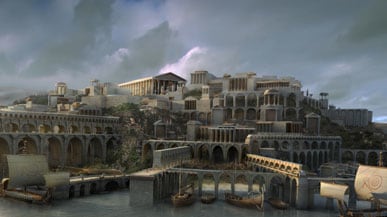To the grim list of cities and places wrecked and ruined by the indescribably awful majesty of earthquake-powered tsunamis— Sendai and Fukushima most recently, Banda Aceh in Sumatra six years ago, the west of Java more than a century back—must now be added one that is more famous and enigmatic than all the rest: Atlantis. For it now turns out that the island-city that for centuries has captured the public imagination as the world’s oldest philosophical wonderland may well have existed after all—and it may have done so right where it has long been thought to have been sited: close to the eastern shores of the Atlantic Ocean.

Beguiling new research into one of archeology’s greatest mysteries appears to have thrown up remarkably persuasive evidence that remains of the ancient city are to be found in the great Hinojos marsh on the southwestern coast of what is today’s Spain. Richard Freund, a somewhat flamboyant professor of Judaica at the University of Hartford, has claimed that the city that has long been regarded—if Plato’s famous description of it as having existed 9,000 years earlier, before Athens, rings true—as the grandmother of human civilization now lies submerged by mud and cottongrass in a part of the marsh designated as a national park a few miles north of the port city of Cádiz. It is a site now padded over by deer and badgers and a few feral camels, nested on by herons and avocets, and overlooked by Spain’s massive expanses of factory-farmed strawberry fields.
Moreover, since Plato declared in his writings that “one grievous day and night … Atlantis was swallowed up by the sea and vanished,” it is especially noteworthy that the newly found evidence also suggests it was a deadly Japan-style tsunami that finally caused the city to sink and disappear.
The United States has long believed it can build its cities wherever it wants to. So it builds New Orleans, below sea level, in a place we now know to be in the bull’s-eye of ferocious tropical storms. It builds Memphis, Cincinnati, and St. Louis perilously close to where this country’s greatest-ever earthquake struck (at New Madrid, Mo., in 1811 ).
Perhaps inevitably, there is much academic squabbling about these new assertions, and some unkindly suggestions of claim-jumping among the numerous scientists who have worked on this latest quest for the site of the “real” Atlantis. But few of the principals dispute the basic claim, made in a recent National Geographic Channel documentary: that a mysterious set of concentric circles that can be easily seen on any good satellite map of the region, when subjected to intense high-tech examination on the ground, show a terrain littered with buried clues of an ancient settlement that appears to have existed there thousands of years ago.
There is nothing unusual about the discovery of a new Atlantis site. Earlier candidates have included sites in India, Finland, Sweden, the Bahamas, Crete, Knossos, Troy, the Bermuda Triangle—even Antarctica. But most sensible research has tended to be guided by a few choice words that Plato wrote back in 360 B.C., in his Socratic dialogue known as Timaeus: “In front of the mouth which you Greeks call, as you say, ‘the Pillars of Heracles,’ there lay an island … Atlantis [where] there existed a confederation of kings, of great and marvelous power.”
This marks the most essential literary clue: that the island-city must have been close to what are now called “the Pillars of Hercules”—the two cliffs marking the mouth of the Mediterranean. In the south is the red sandstone bastion of Jebel Musa in Morocco; in the north, the gleaming limestone massif of the still-British colonial possession the Rock of Gibraltar.
Atlantis, most archeologists have agreed for decades, must have been somewhere near Gibraltar.
The saga of this new discovery began almost 90 years ago when German archeologists, working on this close-to-Gibraltar theory, supposed that the site of Atlantis was somehow connected to that of another lost city, an eighth-century B.C. Phoenician trading post near the Spanish coast known as Tartessus. Writings, much later than Plato’s, had hinted that Tartessus was probably in Andalucía close to the Guadalquivir River, just to the north of Cádiz—just 60 miles from the British outpost.
Then, eight years ago, a pair of German scientists hunting for clues in Andalucía were examining satellite pictures of a large wildlife marshland reserve and bird sanctuary nearby, the Doña Ana National Park. Suddenly they spotted something very odd: a seemingly perfect circular structure set deep in the swamp, with a roadway of some kind leading to the river and a set of rectangular markings nearby.
It all looked artificial and quite out of place in an otherwise undifferentiated wilderness of marsh. (The site can be seen by putting in the coordinates 36 57.25N, 6 22.58W onto a satellite map. It is a remarkable site, and you will gasp.) Since Plato had described the city as having been composed of concentric circles, then this, said the Germans, might well be it.
In 2006 a group of Spanish archeologists then set out to prove the German speculations. Finding it immensely difficult (the swamp is water-covered for most of the year, drying out only in August), they turned to an American investigator well known for his use of loaned high-tech equipment: Hartford’s Freund.
Freund jumped at the chance. He asked his contacts at a Canadian oil-exploration firm to fly in both ground-penetrating radar (which can “see” a dozen feet down) and much newer electrical-resistivity-tomography equipment (which can gaze even deeper). Experts from the University of South Florida’s geography department also came and, along with Freund, a Canadian movie company working on commission for the National Geographic Channel.
With the filmmakers busily recording, the electronic detectors promptly found beneath the circles and oblongs visible by satellite a number of enticing layers and straight-line structures that Freund then suggested the Spaniards drill into and otherwise excavate. Within days they had found hard evidence—discoveries of where a circular wall might have been, of a stele marked with carvings of what might have been an Atlantean warrior, of stones decorated with city symbols, of ancient wood dated at 3100 B.C., and of a methane-rich layer suggestive of the sudden simultaneous death of a great number of inhabitants.
It looked as though some catastrophe had enveloped the entire community. To prove it might have been a tsunami (to which the Iberian coast has been historically prone: the 1755 Lisbon earthquake saw one of Europe’s worst), Freund went out to sea. He sent down divers, and, according to his claims made in the National Geographic movie, they found enormous quantities of submerged carved stones. Perhaps, Freund said, they were part of the Atlantis wall, wrecked and then dragged out into the ocean by the merciless undertow for which big tsunamis are notorious.
Finally, Freund went on to claim the finding, some 100 or so miles away at a number of sites in central Spain, of what he called “memorial cities”—places that were never inhabited, but that the Atlantean tsunami refugees built as miniature, “toy” versions of Atlantis, to remind them of the onetime greatness of their former home.
This set of finds, Freund declared, provided the final confirmation. Atlantis, he said he had proved, was in a swamp in Spain, had vanished under a mighty earthquake-generated wave some 4,000 years ago (Plato’s 9,000 years was simply a figure of speech, like saying eons ago), and its inhabitants had fled into the Spanish hinterland to be absorbed back into the local culture.
The Spanish archeologists fumed. Their spokesman, Juan José Villarias Robles, accused Freund of parachuting into their site (he spent only a week there, he admits), of making exaggerated claims (there was no wall ever found, said the Spaniards), of publishing “fantastic” and “outrageous” assertions, and of failing properly to acknowledge his “ethical indebtedness” to the Spanish and earlier German workers. But what Villarias Robles does not say—nor does anyone else—is that the claim is basically wrong. Feathers may have been ruffled, rivalries exposed, egos paraded, and personal claims exaggerated—but the main body of facts appears not to be in dispute. An ancient ruin may well have at long last been found.
All of which raises some other, more general issues of planetary history, issues that may bring us back to the most worrisome questions that have been raised in the aftermath of the terrible Japanese earthquake.
Mythical cities and islands have peppered our history. The Atlantic Ocean in particular is awash with islands that never existed. There was, for instance, St. Brendan, to the south of Iceland (and which Charles Kingsley used as home to his Water Babies book, with its memorably named Mrs. Doasyouwouldbedoneby); there was Antillia, near Bermuda; there was the weirdly named Hy-Brasil, off Ireland; the Isle of Demons, off Newfoundland; Santana, also off Bermuda; and Buss Island, west of Scotland.
And ruined cities pepper our present day, too. Cities like Pompeii and Petra, Heliopolis in Egypt and Ayutthaya in Thailand, Ur and Jericho and Babylon in the Fertile Crescent. As tourists, we go and visit them and we take photographs, yet seldom we stop to wonder: why were these cities ruined? Why did Pompeii die, and yet cities like Rome and Berlin and Paris and Moscow, which had their origins at much the same time, continue to exist and flourish?
The answer, of course, is that these emptied cities were mostly put down in places where, it later turned out, they should not have been built in the first place. Each was ruined or wrecked by some aspect of its location that made it unsuitable as a building site. Pompeii was in the shadow of a volcano, Babylon was in a waterless desert, Ayutthaya in an indefensible valley, Petra too far from cultivable fields. And so the inhabitants eventually left, or died, and no one ever came again.
The United States has long believed it can build its cities wherever it wants to. So it builds New Orleans, below sea level, in a place we now know to be in the bull’s-eye of ferocious tropical storms. It builds Memphis, Cincinnati, and St. Louis perilously close to where this country’s greatest-ever earthquake struck (at New Madrid, Mo., in 1811 ). It builds cities like Tucson and Phoenix in waterless deserts. Most notoriously of all, it builds the city of San Francisco—dead center on top of one of the most mobile tectonic-plate boundaries in the world.
So, with the map of Richard Freund’s discoveries in Spain firmly in our mind today, let us ask: what might a map of America look like after 500 more years of earthquake, flood, and fire? Will San Francisco still be there, and New Orleans? Will Memphis have been wrecked by the Missouri fault? Will Oregon have been ruined by giant waves? Will Mobile have fallen to hurricanes? Will some cities have been left derelict and empty, maybe buried like Atlantis, below the mud of a marsh that may by then be famous for its birds and its badgers, but otherwise given over to its true master, the forces of nature? Did the inhabitants of Atlantis ever imagine 4,000 years ago that they would be wiped out by a tsunami overnight? Did the good people of Sendai ever imagine that the same terror might ever be visited on them? Does anyone these days ever take into account what nature can truly do when nature puts her mind to it?
That is perhaps what some of us should ponder when we consider the fate of Atlantis. For is the fate of that fabled city likely, in the end, to be our fate too?
Simon Winchester is the author, most recently, of Atlantic.





